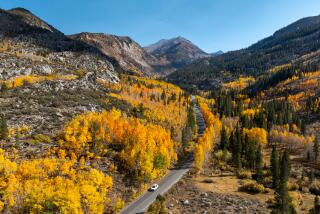Southern California Careers / Dream Jobs : Exotic Tour Guides: They Go to Work at Being on Vacation
- Share via
Mt. Everest, at 29,028 feet, is so high that its summit is often covered by a plume of clouds from the jet stream. When the world’s highest mountain does come into view, it most often appears as a massive black pyramid. But tour guide Rusty Brennan says the most colorful view of Everest begins near sunset from a clearing 18,190 feet up in Nepal, where the summit is only a couple of miles away, and almost all of that gap is vertical.
Twenty minutes after sundown, Brennan says, Everest’s colors explode, as sunlight is reflected off the stratosphere and the great mountain is bathed in shades of orange, blue and purple.
Some climbers are brought to tears at this spot, he says, having come so far just to see Everest. As the sun lets go, so do their emotions.
“I like going places to introduce people to a unique environment. It’s a fun part of my job,” says Brennan, 39, of the Seattle area, who has been leading hiking and cycling trips to Nepal and Tibet for 17 years.
Whether it involves guiding visitors through white-water rapids in the Grand Canyon, hunting for black bears in Canada or urging the weary to take one more step as they ascend some of the world’s highest mountains, being an exotic tour guide is one of life’s dream jobs for those who love the stimulation of the outdoors and seek out places rarely visited.
*
Brennan now leads Asian tours for REI Adventures in Sumner, Wash. His trips to the Mt. Everest area vary, some lasting as long as 23 days. The groups are small, about 10 participants plus six Sherpa guides and seven yaks to carry all the camping gear, supplies and food.
Although these are hiking trips--the groups don’t attempt to scale Everest--the expeditions still require acclimatizing to high altitude. The airstrip nearest Everest is 9,200 feet above sea level. From there Brennan limits his group’s ascent to 1,000 feet a day, with every third day set aside for rest.
“Any mortal can walk” here, he says. But Brennan does not carry oxygen, and the lighter air means headaches, nausea and loss of appetite for many until their bodies adjust.
Every time Brennan goes to the Himalayas, “the mountains are always higher than I remember.” Clouds may obscure the peaks for the first day, and “then somebody says, ‘Look, there’s one,’ and I always look too low. The summits are higher than you anticipate.”
Brennan began crafting his career after visiting Nepal during college. He was taken by the culture, the beauty and the people, so he shifted his major in anthropology to central Himalayan studies.
“How did I get this job?” he says. “I spent a lot of money on airline tickets, and I’ve literally walked thousand of miles.” He started leading his own tours to Nepal, then helped REI set up its own tour network.
*
Eight years ago, Garrett Schniewind, 33, of Arizona was teaching customer service operators at giant investment firm Fidelity about the wonders of mutual funds. Now he navigates rafts full of passengers as a guide on white-water trips along the Colorado River inside the Grand Canyon.
He quit his investment job when his mother bought Canyon Explorations in Flagstaff, Ariz. As a boy, Schniewind took to canoeing in the wilderness, and now he and his sister lead non-motorized rafting trips, the longest of which last 16 days and cover 226 miles.
For most of Schniewind’s customers, the trips offer a chance to escape from the rapid pace of urban life. Still, some visitors ask if they can bring along their cellular phones, and Schniewind happily tells them that the phones won’t work within the steep canyon walls.
By the third day, he says, his passengers have calmed down and are concentrating on simpler things, such as “having a meal, getting warm and dry and ending the day with a little bit of good company” as the group camps along the river.
About 90% of the Colorado River is calm water; it’s the other 10%, the rapids, that offer the heart-stopping excitement. Sometimes passengers even go overboard, he says. The water is cold--usually 47 to 54 degrees.
Although Schniewind has been down the Colorado River 71 times, he still remembers the first time he got tossed into it.
“The strength of the river is a lot stronger than anything we possess,” he says. “It is humbling, and it should be.”
Still, when one of his passengers goes overboard, he says, “frequently that becomes the highlight of their trip.”
*
When Larry Adams went hunting, it was a treat; when he returned to his regular work as a grain farmer in Iowa, it was only a job. So nine years ago, Adams, 43, quit, learned to fly and has since been making a living as a charter pilot and fishing and hunting guide. He lives in Iowa during the off season and spends summers in Ontario, Canada.
In May, when the ice melts on the lakes in Ontario, he flies off in his Cessna to collect his fishing customers. The plane is fitted with pontoons so Adams can land on water to set the group up at isolated lakefront cabins. “It’s a great getaway, just to go outdoors for some hard fishing,” he says.
In the fall, when hunting season opens for black bear and moose, his clients usually “want a trophy,” Adams says. That means a 400-pound bear or 1,000-pound moose, so they can have the antlers mounted or the skin made into a rug.
The legal limit, though, is one bear or moose. So his clients “pass up a lot of smaller animals to get a bigger one,” he says. Though they may not get that lucky. Days can pass with not another bear or moose to be found. “For somebody who has not hunted before, they can be pretty disappointed.”
*
Frith Maier, 32, grew up surrounded by mountains in Juneau, Alaska.
“I’m drawn to remote places,” she says. “And the high mountain world is as remote as you can get.”
Now she leads trips for REI Adventures, and her specialty is the Pamir mountain range in a southern stretch of the former Soviet Union near Afghanistan. After Nepal, Maier says, this is the elite class of peaks, with three mountains topping 23,000 feet; the highest is Communism Peak at 24,590 feet.
Often the trips Maier leads are mountain climbing, not hiking, trips, replete with ice, ropes, crampons, harnesses, the perils of avalanches and, of course, a goal of reaching the summit. However, Maier warns her customers--all of whom are fit climbers--that their chances of reaching any summit are less than 50%.
“They might not have the willpower,” she says, plus there is snow and altitude sickness.
Some years ago, Maier led a group to within 500 feet of the summit of Communism Peak before high winds halted their ascent. The next year she went back, leading a group of a dozen customers, along with six veteran Russian mountain climbers as guides.
They camped within 3,000 feet of the summit, and the next morning was clear, so they pushed for the top.
“It was hard. Until you’ve been at that altitude, it’s hard to experience that it is possible to move so slowly,” Maier said. “You have to strike bargains in your head, like you can’t stop for 10 steps.”
When she finally touched the summit, Maier had no great epiphany. “I was fantasizing about eating grapes. That sounds kind of kinky,” she says. But at that altitude, “your mind wanders far off from reality.”
More to Read
Sign up for The Wild
We’ll help you find the best places to hike, bike and run, as well as the perfect silent spots for meditation and yoga.
You may occasionally receive promotional content from the Los Angeles Times.







